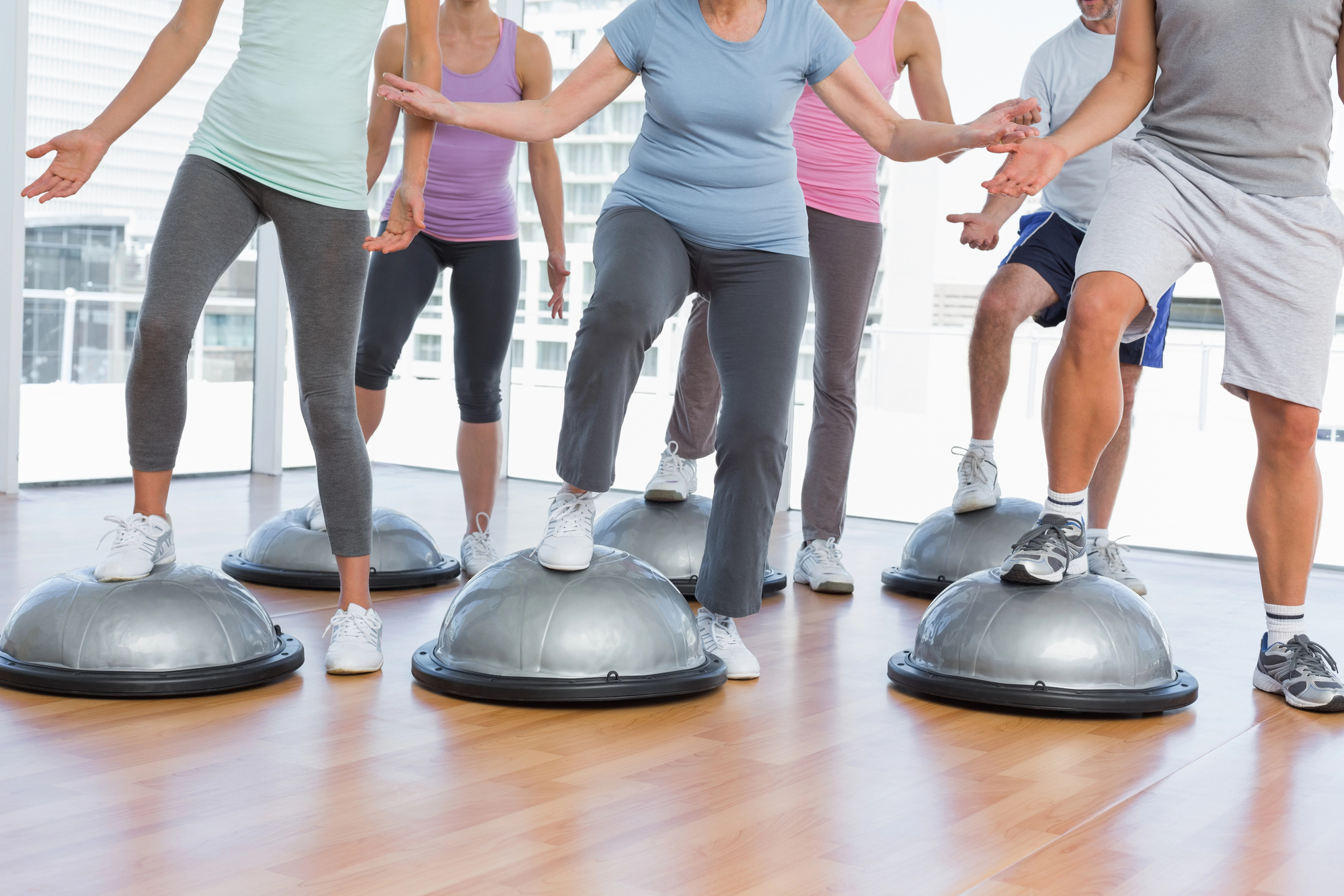Balance and flexibility are critical to living a full and active life. While we are young, it is easy to overlook the importance of balance, but as we age, our mobility is key to remaining active. In fact, the National Council on Aging emphasizes that senior exercises, particularly focused on core strength, balance and mobility, support your physical health, but also aids in improving your mental health as well. At a high level, some key benefits of staying active and integrating routine workouts.
- Prevents Bone Loss: We lose bone density as we age, so routine exercise helps reduce this loss and strength training works aid in restoring bone density. Additionally, stronger bones helps reduce your fall risk and aids in balance.
- Relieves Pain: Increasing your movement helps reduce pain and stiffness. For those with stiffness and Arthritis, then low-impact cardiovascular activity, strength training, and range-of-motion exercises help reduce some of the daily pains and improve your balance.
- Reduces Risk of Chronic Disease: Regular exercise provides a protective effect against the risk of chronic illnesses, including cardiovascular disease, colon cancer, diabetes, obesity, and hypertension. Additionally, a recent study found 30 minutes of daily exercise helped reduce cognitive decline.
- Boosts Immunity: A 2018 study linked moderate exercise with a lower incidence of acute respiratory illness. While the science behind the study results remains a mystery, the general theory is that the anti-inflammatory effects of physical activity enable better immune function
- Improves Mood: Exercise helps ease anxiety and depression symptoms, while generally creating a better sense of wellbeing. A 2019 study of adult men age 65 and older found that the mood-boosting benefits of exercise continue well into old age, underscoring why it’s so vital to stay active.
As part of a well-rounded exercise routine, it is important to dedicate some time to balance workouts. The Mayo Clinic highlights the importance of balance workouts for seniors because they help reduce fall risk, which allows seniors to maintain their independence and overall healthy. While any exercise, such as walking, helps seniors improve mobility and their balance, there are specific exercises the can be incorporated into your routine and improve your stability. A few key benefits of balance exercises for seniors:
- Prevent Falls and Injuries: As people age, balance and stability often decline, increasing the risk of falls and related injuries.
- Improve Quality of Life: Good balance enables seniors to continue performing daily activities and stay mobile, which is crucial for their overall health, comfort, and sense of independence.
- Enhance Physical and Mental Functioning: Balance exercises can improve physical abilities like strength, flexibility, and coordination. They may also boost mental functions like memory and spatial cognition.
- Promote Confidence and Reduce Fear: When seniors feel more stable and secure in their movements, they are less anxious about falling, which can improve their confidence and quality of life.
- Complement Other Fitness Activities: Balance workouts are recommended to be incorporated alongside other exercises like strength training, cardio, and stretching for a well-rounded fitness routine as we age.
Overall balance exercises are a critical aspect of maintaining your long-term health, independence, and quality of life.
What are Simple Balance Exercises for Seniors?
Fortunately, there are simple and easy-to-learn balance exercises that can be incorporated into your workout routine. WebMD offers some exercises that target your core, leg, and hip muscles, which are crucial for maintaining good balance as you age. Be sure to hold onto a chair or wall at first, and consult your doctor before starting any new exercise program.
- Single Leg Balance: Stand with feet shoulder-width apart, and hold onto a chair if needed. Slowly lift one leg, hold for 30 seconds, then switch legs. This improves stability and coordination.
- Tree Pose: Stand with feet together, and place one foot on your ankle, calf, or inner thigh. Hold for 30 seconds, then switch sides. This yoga pose challenges to balance.
- Tightrope Walk: Walk heel-to-toe along a straight line, like a tightrope. Extend arms out to the sides for balance. Walk for 5 seconds per step.
- Flamingo Stand: Stand near a wall, and lift one leg up towards your hip. Hold for 10-20 reps per side to strengthen hips and core.
- Lunges: Step one leg forward, bending both knees to lower into a lunge. This improves balance and leg strength.
What are Modifications for Balance Exercises for Seniors?
As with all exercises, completing the task properly with accurate technique is the key to success. For seniors who are working to improve their balance, then some of the suggested exercises may be too difficult to do when starting, so it is important to modify them accordingly. Fortunately, there are standard modifications to basic balance exercises, which GoodRx outlines for seniors who need help, are coming off injuries, or have any disabilities.
- Use Assistive Devices: Hold onto a chair, counter, or wall for support during exercises like single-leg stands or tree pose.
- Adjust Difficulty Level: Start with easier exercises, such as seated or chair-based exercises before progressing to more challenging standing exercises. Additionally, reduce the time or number of reps for balance exercises, as needed, or attempt these exercises with a wider stance or holding onto a surface for more support.
- Accommodate Physical Limitations: Modify yoga poses like tree pose by placing the non-standing foot on the ankle, calf, or inner thigh instead of the upper thigh. Additionally, know your body, so for seniors with arthritis, avoid putting pressure on the knee during exercises. Also, consider a balance cushion or pad to add instability and challenge the core, while still providing support.
- Consider Your Safety First: Perform exercises near a sturdy chair or wall in case extra support is needed. Also, avoid exercises that require quick movements or sudden changes in direction, which can increase fall risk.
Finally, and perhaps most importantly, if you feel uncomfortable or not sure if you are physically capable of doing any type of workout, then consult a physical therapist. Together, you can develop a personalized balance program based on your specific needs and abilities.
How to Incorporate Balance Workouts?
As the saying goes, slow and steady wins the race. With exercise, then the key to success is starting slowly to gain confidence as the tasks become part of your workout routine. Over time, you’ll start to notice the difference and your confidence will continue to grow. To help stay motivated and incorporate the balance exercises that work for you, consider one (or a few) of the following ideas:
- Make it Social: Incorporate balance exercises into group activities like senior fitness classes, walking groups, or dance classes. After all, exercising with a friend or group makes it a social event.
- Set Small, Achievable Goals: Start with simple goals like adding 5 more minutes of balance exercises per day, and don’t forget to celebrate when you reach a milestone, like being able to do a balance pose without support.
- Visualize the Benefits: Imagine yourself being able to do activities you enjoy, like playing with grandchildren or dancing at a wedding. Visualizing the positive outcomes can inspire you to keep up with balance training.
- Pick Activities You Enjoy: Choose balance exercises that you find fun, like tai chi or yoga, rather than seeing them as a chore. Also, incorporate balance into hobbies like gardening, golfing, or walking the dog.
- Reward Yourself: Treat yourself to something special when you reach a balance exercise goal. For example, the reward can be as simple as buying a new book or scheduling a fun outing.
- Get Support from Loved Ones: Ask family and friends to encourage and remind you to do your balance exercises. Also, working with a workout partner can boost motivation and consistency.
Like anything that becomes part of our routines, the key to integrating balance workouts remains making them enjoyable and engaging. And ultimately, by incorporating these balance exercises, then seniors can stay motivated to continue improving their balance and reducing fall risk over the long term.
From helping with fall prevention to looking younger to warding off depression in seniors, intentionally making exercise part of a senior’s routine can support a healthier and happier life. Many of these balance workouts can be done at home, and seniors living in a community like Arbors of Hop Brooks can leverage the available wellness programs to support their efforts. To learn more about everything that our comprehensive care community has to offer, contact us today!


